1. Prevalence data and victim surveys
2. Costs of domestic violence
3. Age distribution of domestic violence
4. Number of deaths
1. Prevalence data and victim surveys
Greece was among the thirteen countries that first signed the Council of Europe Convention on the Prevention and Combating of Violence against Women and Domestic Violence (hereinafter referred to as “the Convention”), in Istanbul on the 11th of May 2011. The Greek Parliament ratified on 18th of June 2018 the Convention by Law 4531 and adjusted relevant provisions of domestic legislation. The Convention entered into force on the 1st of October 2018
Was established on 27 June 2023 the new Ministry for Social Cohesion and Family with a view to promoting policies for the gender equality but also the solution of the demographic problem and aging population.
The newly established Ministry was assigned responsibilities old ministries and the new General Secretariat for Equality and Human Rights was established in it.
The General Secretariat for Equality and Human Rights (GGIAD), is the competent government body for planning, implementation and monitoring the implementation of policies for equality between women and men in all fields.
The following data provided on domestic violence come from the 4th Annual Report on Violence against Women by the Hellenic ministry for Cohesion and Family (GGIAD).
These data reflect, to a certain extent, the dimension of the phenomenon within Greek society.
1. HELLENIC POLICE DATA
Table 1: Indicators on violence against women, from Hellenic Police (2010-2022)
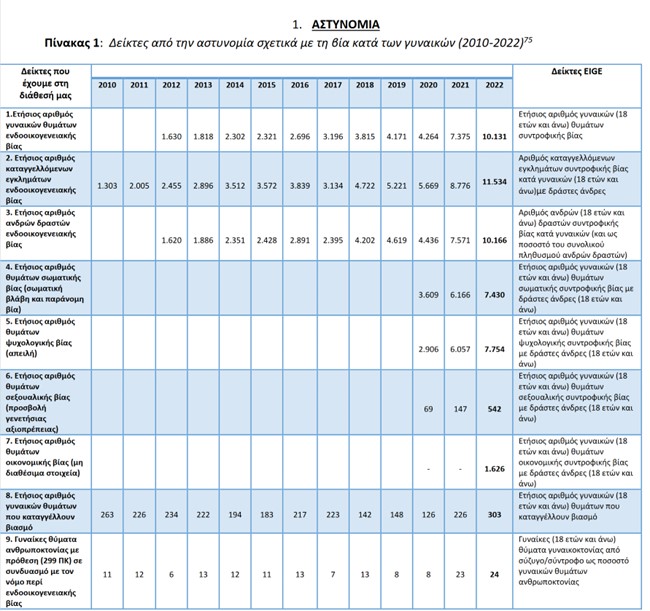
Number of reported forms of intimate partner violence (18 years or older), perpetrated by men
Annual number of male perpetrators of domestic violence
Annual number of victims of physical violence (physical harm and illegal violence)
Annual number of victims of psychological violence (threat)
Annual number of victims of sexual violence (indecent assault)
Annual number of victims of economic violence (unavailable data)
Annual number of female victims who have reported rape
Female victims of premeditated murder (Article 299 CrCo) in conjunction with the law on domestic violence
Indicator 1: Annual number of female victims of domestic violence
Figure 1: illustrates the continued increase in the total number of female victims of domestic violence who made a report to the police and the continued increase in 2022. Between 2012-2020 the increase in the number of complaints ranged from 1-26%.In 2021 there was a rapid increase in complaints, of 72.9%. Thus, compared to 2020, the number of women who reported domestic violence in 2022 to the police more than doubled, reaching 137.6%, as 4,264 women had made a complaint in 2020 while in 2022 the number rose to 10,131.
Figure 1: Annual number of female victims of domestic violence (2010-2022, ELAS.)
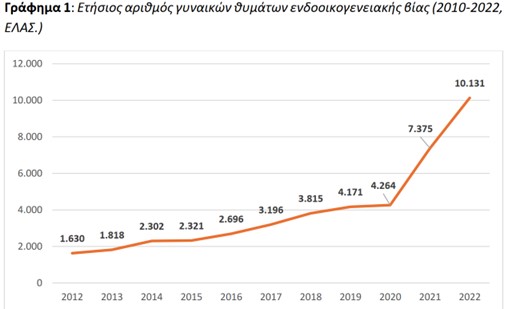
In relation to the total number of victims of domestic violence, women make up three quarters of the victims who report to the police (see Figure 2).
Figure 2: Number of victims by gender (2022, ELAS.)
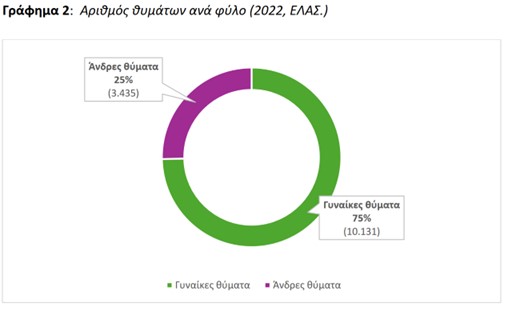
Purple: Male victims
In most cases the victim appears to have maintained, either during at the time of the crime or in the past, a partner or spouse relationship with the offender. From the police evidence on the victim-offender shows that, once again, the highest rates of violence are recorded in partner relationships (59.4%).
Figure 3: Victim-perpetrator relationship in domestic violence incidents (2022, ELAS.)
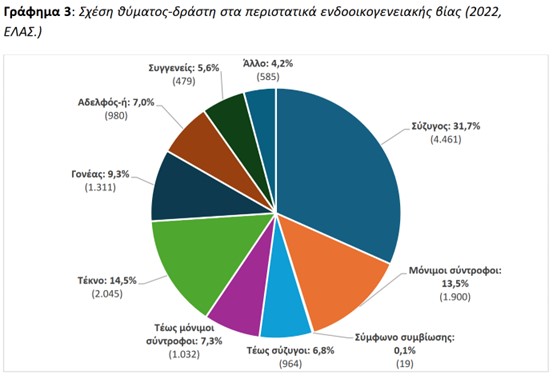
More specifically, the largest percentage of offenders are the spouses of the victims (31.7%, 4,461). The permanent partners of the victims are perpetrators of domestic violence crimes account for 13.5% (1,900), while former partners and former spouses record lower percentages, 7.3 per cent (1,032) and 6.8% (964) respectively.
The next three categories of victims of domestic violence, after victims of intimate partner violence, are the children of the perpetrators (14.3%), the parents of the perpetrators (14.3%), the parents of (9.8%) and their siblings (7.2%).
Indicator 2: Annual number of reported domestic violence crimes
The annual number of reported domestic violence crimes in the year 2022 shows an increase of 31.4%, compared to 2021, doubling the number of reports in 2020 (103.5%).
Figure 4: Annual number of reported domestic violence crimes (2010-2022, ELAS.)
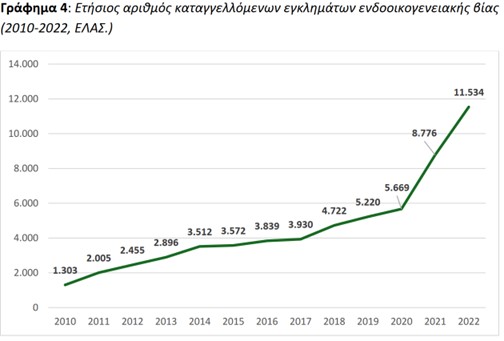
Indicator 3: Annual number of male perpetrators of domestic violence
Similar to the previous indicators, a similar increase was observed in the number of victims of domestic violence. annual number of male perpetrators of domestic violence in 2022.
Figure 5: Annual number of perpetrators of domestic violence crimes (2012 – 2022, ELAS.)
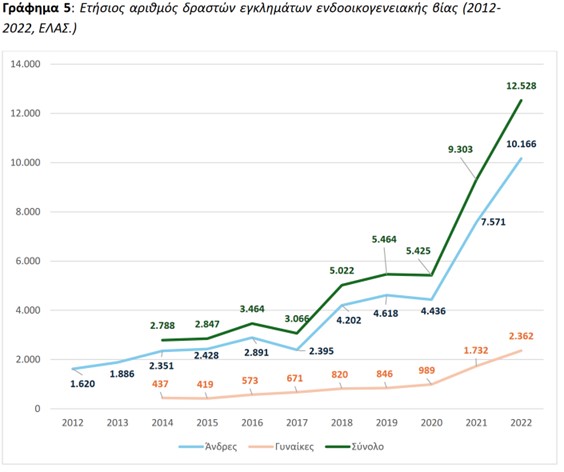
The number of male perpetrators of domestic violence rose to 10,166 in 2022, an increase of 34.3% compared to 2021. A similar increase appears to be increase in the number of female perpetrators, as in 2022 they amounted to 2,362, 36.4% more than in 2021.
Indicatively when examining the phenomenon of domestic violence is the data comparing the percentage of perpetrators of this crime in relation to the total number of perpetrators who were reported to the police for any offence (see Graph 5).
Figure 6: Annual number of perpetrators of crimes in total (Σ) and in domestic violence (ΕΝΔ) by gender (2020-2022, ELAS.)
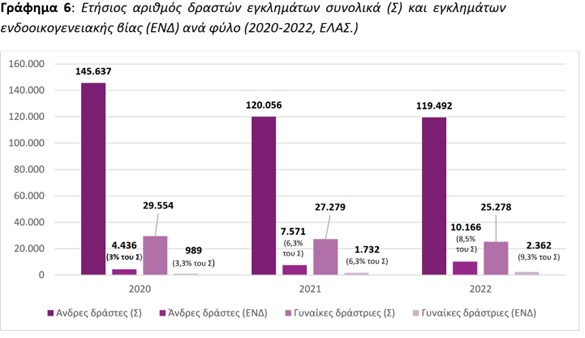
Data from the past three years show that while the total number of perpetrators of crimes overall, regardless of gender, is declining, the total number of perpetrators of domestic violence is rising.
In 2022, male domestic violence perpetrators accounted for 8.5% of the total male population employed by ELAS, while the Greek Government and the Greek Government of Hellenic Police (Elas) are 9.3% of women perpetrators of crimes.
The four different forms of violence identified in the police data are presented below, according to the ways in which the offenses are committed.
Figure 7: Annual number of domestic violence by type of violence (2020-2021, ELAS.)
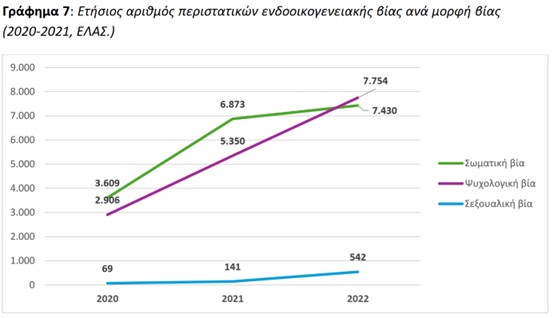
Purple: Psychological violence
Blue: Sexual violence
As shown in the above Graph, most recorded incidents relate to physical and psychological violence (fourth and fifth indicators). The number of physical violence cases in 2022 remained relatively stable compared to the rapid increase recorded in 2021.
While the number of cases of psychological violence continued to rise, it recorded an increase of 44.9% compared to 2021. Violence is recorded in the offenses of domestic threat and illegal violence (Article 7 of Law 3500/2006), while in one incident there may have been more than one way of violence.
The sixth indicator (annual number of women victims of sexual domestic violence by male perpetrators) records allegations of sexual dignity (Article 9 of Law 3500/2006), as well as two cases of abuse of a child to resist a sexual act (Article 8(2) of Law 3500/2006 and Article 338 of the PR). Compared to 2021, in 2022 complaints to the police more than tripled as from 141 amounted to 542 increase of 284.4%).
For the first year, the data for the seventh indicator on the annual number of women victims of domestic violence are published this year. As in Greek law there is no separate provision for economic violence, this indicator shows the data relating to refusal of the maintenance payment. The very gender-specific dimension of this form of violence is reflected in the fact that in 2022 the number of women who have the complaint amounted to 1,626 and the number of men.
Indicator 8: Annual number of female victims reporting rape
The total number of rapes reported to the police by women in 2022 amounted to 303. With regard to allegations of rape within the family, it appears that 2022 recorded 88 cases with 86 men assailants and 87 victims.
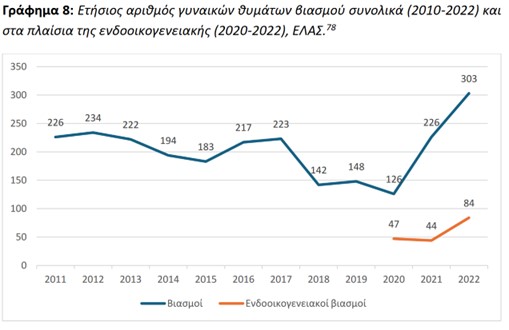
Orange: Domestic rapes
The general increase in complaints to the police about gender-based violence is also recorded in the number of women who reported rape. The multiplication of cases recorded after 2020 is also interpreted as a result of the visibility received by the phenomenon through emerging in the public sphere during the pandemic.
Thus, in 2022 there were 303 cases of rape of women, 34% more than in 2021 and 140% more than in 2020. The number of male rape victims in 2022 was 31
At the same time, over the last 3 years we have also data on rapes committed within the family. As shown in Figure 7, adult female victims of domestic rape amounted in 2022 to 84, while male victims of domestic rape committed inThe complaint concerned 3.
The vast majority of the perpetrators had a relationship with the victim of rape, either at the time the crime was committed or in the past. In 20 out of 85 cases the perpetrator was the victim’s spouse (23.5%), in 29 cases the former permanent partner (34.1%), in 20 cases the permanent partner (23.5%) and in 4 the former spouse (4.7%).
Figure 9: Percentage of male domestic rape perpetrators by relationship victim (2022, ELAS.)
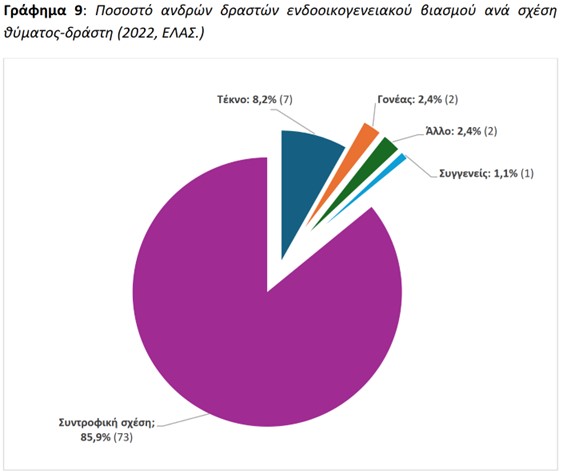
Dark Blue: Child
Orange: Parent
Green: Other
Light Blue: Relatives
Indicator 9: Annual number of femicides
As in Greece there is no separate provision for the criminal prosecution of the crime of femicide, the dimension of the phenomenon in the country is reflected by the concentration of the total number of female victims of manslaughter with intent (Article 299 of the Criminal Code), while their relationship with the perpetrator arises in conjunction with the Law on the Treatment of Domestic Violence (N. 3500/2006).
According to police data, 2022 increased both the number of femicides compared to previous years, and the percentage of femicides in the total number of female homicide victims.
Figure 10: Annual number of femicides (2010-2022, ELAS.)
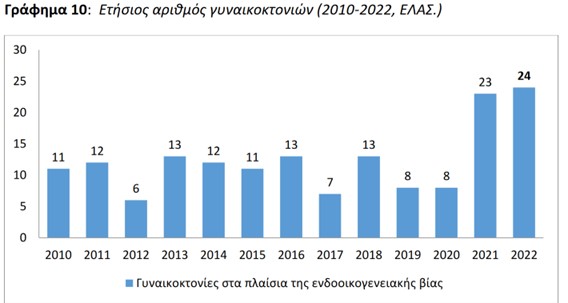
In 2022, twenty-four (24) femicides were recorded in Greece. The number of women murdered by a member of their family remained high and increased by one year compared to 2021.
At the same time, the total number of female homicide victims rose to 45, marking a significant increase compared to 2021 (36.4%), the second highest number of female homicide victims in the last 13 years, and for another year also, femicides in the domestic murder accounted for the largest proportion of recorded homicides involving women (53.3%).
Table 2: Annual number of women (18 and over) victims of femicide under the Domestic Violence Act as percentage of women victims of homicide (2010-2022, ELAS.)
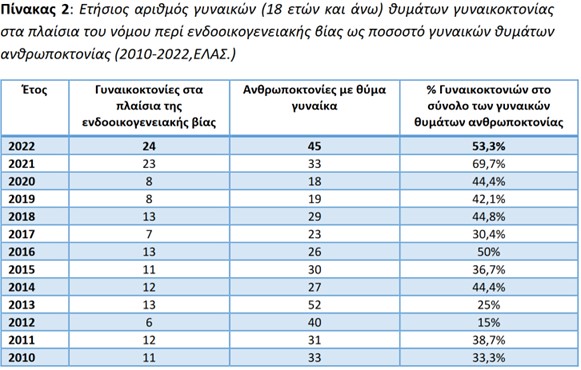
As for the relationship between the victim and the perpetrator, it turns out that most of the cases are partner violence, as 13 women were murdered by their current or former partner or husband (54.2%), 8 women were murdered by their son (33.3%), 2 by their father (8.3%) and 1 by her grandson (4.2%).
Figure 11: The relationship between the perpetrator of femicide and the victim (2022, ELAS.)
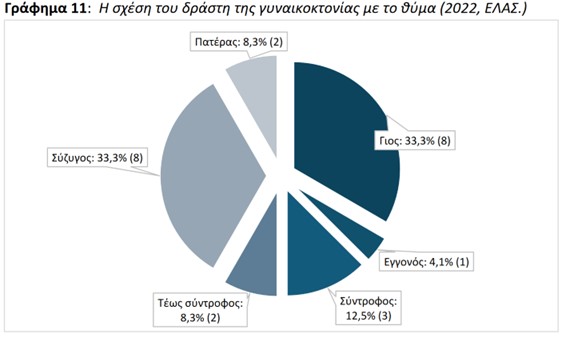
CYBERVIOLENCE
This section presents the data collected by the Gender Equality Observatory from the Electronic Crime Prosecution Directorate of Hellenic Police regarding online violence.
Figure 12: Rate and number of victims of online threats by gender (ELAS., 2022)
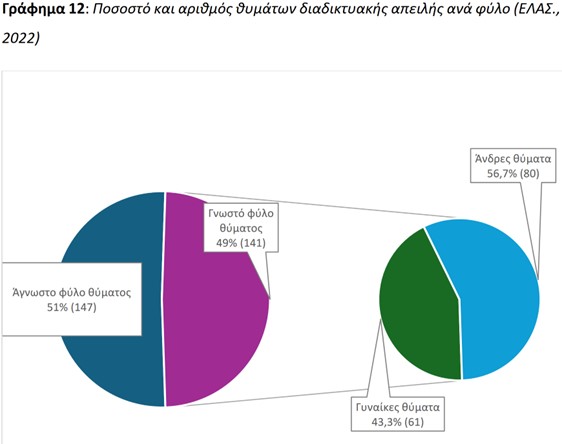
Purple: Known gender of victim
Green: Female victims
Light Blue: Male victims
Figure 13: Rate and number of revenge porn victims by gender (ELAS., 2022)
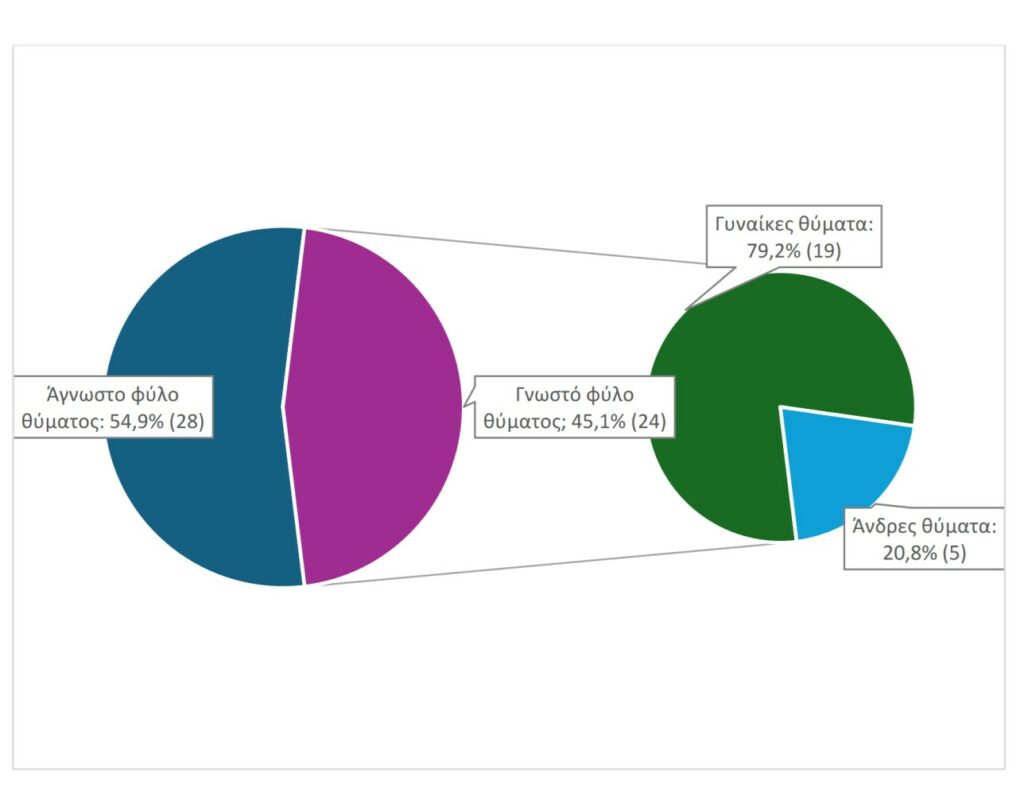
Purple: Known gender of victim
Green: Female victims
Light Blue: Male victims
2. JUDICIARY
Data relating to the evolution of domestic violence cases within the criminal justice system, focusing on the period 2016-2022.
The graph below gives a picture of the cases domestic violence cases in the justice sector. For each year it shows the data for the articles of the Law on Domestic Violence (Law 3500/2006) relating to domestic physical injury (Article 6), domestic unlawful violence and threats (Article 7), rape and abuse of indecent assault (Article 8) and domestic assault on sexual dignity (Article 9). The six lines represent criminal prosecutions (blue),verdicts (dark green), appeals against judgments of first instance (purple), the convictions at first instance (orange), suspended judgments (light blue) and convictions at second instance, i.e. at the Court of Appeal (light green) per year in the period 2016-2022. We should note that acquittals, convictions and judgments and one-year appeals do not represent the evolution of criminal prosecutions brought in the same year. For example, 3,115 domestic violence prosecutions were brought in 2022, yet 4,449 domestic violence cases were deferred in the same year.
Figure 18: The evolution of domestic violence in the justice sector in Greece (2016-2022, JustStat)
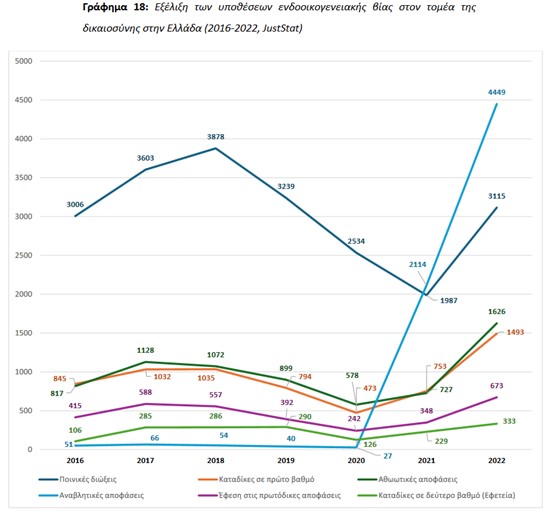
We first observe a significant increase (29%) in the number of prosecutions brought between 2016-2018 for cases domestic violence cases, but also a rapid decrease (51%) – by half – in the number of cases in which criminal prosecutions were brought in the period 2019-2021.
The second striking fact that stems from the data of the of the judiciary relates to the sharp increase in the number of suspensive decisions were issued in the years 2021 and 2022.
While in the period between 2020 and 2020, the number of suspended judgments in domestic violence cases ranged from 27 to 66 per year, in 2021 these amounted to 2,114 and in 2022 to 4,449. This rapid increase is due to the conditions imposed by the coronavirus pandemic, highlighting the backlog of justice for victims of domestic violence as a further negative consequence of the way the pandemic was managed.
The last indicator (see Table 3) concerning the data of the justice system focuses on the annual number of new entrants to the prison system who received convicted in the current year and serving a sentence in a penitentiary for domestic violence against a family member their family member. The data was compiled by the Department of Strategic Planning and Evaluation of Anticrime Policy of the General Secretariat for Anticrime Policy of the Ministry of Citizen Protection and relate to all the detention facilities in the country.

3. SUPPORT TO VICTIMS: EKKA The SOS helpline 15900
The calls received by the EKKA 24-hour 197 Helpline also included incidents of gender-based/ domestic violence. Helpline officials provide psychosocial support services to victims of domestic violence and set direct social intervention mechanisms in motion. The table below shows data collected by the Observatory in the period 2018-2021 concerning female victims of violence, as well as third persons who called the EKKA 197 Helpline.

2022, 80% of the 244 victims of violence who called the 197 line were women. There was a significant increase in the number of underage girls who called the 197 line compared to 2021-when only one juvenile victim of violence and no minor third party had called the 197 line. In 2022 of the 195 female victims of violence who called the 197 line, 25 were minors. Furthermore, while the line was called to report an incident gender/domestic violence and 101 female third parties, 66 of them were adults and 35 were minors. The number of male victims of violence (49) who called to the line amounts to a quarter of the number of female victims, making up one-fifth of the total number of calls from victims received by the Line.
4. IMMIGRATION
The data of the Gender Equality Observatory regarding victims of domestic violence who have received a residence permit in Greece, are collected in accordance with paragraph 1c of article 19A of Law 4251/2014 – as defined in Law 3500/2006. According to the above article, victims of domestic violence are entitled to receive a residence permit for one year, which can be renewed each time for up to two years if the same conditions are met. At the same time, a residence permit of the same duration is granted to the minor children of victims of domestic violence.
Table 6. Annual number of residence permits issued to third-country nationals humanitarian reasons as victims of domestic violence, by gender and by country per year (2018-2022, General Secretariat for Migration Policy)
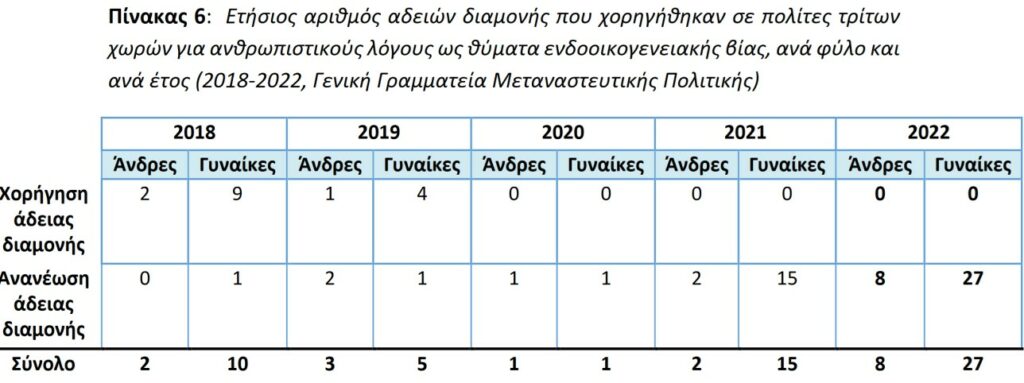
2. Costs of domestic violence
From European Institute for Gender Equality:
Costs of gender-based violence in Greece is 8.8 billion each year (2021)
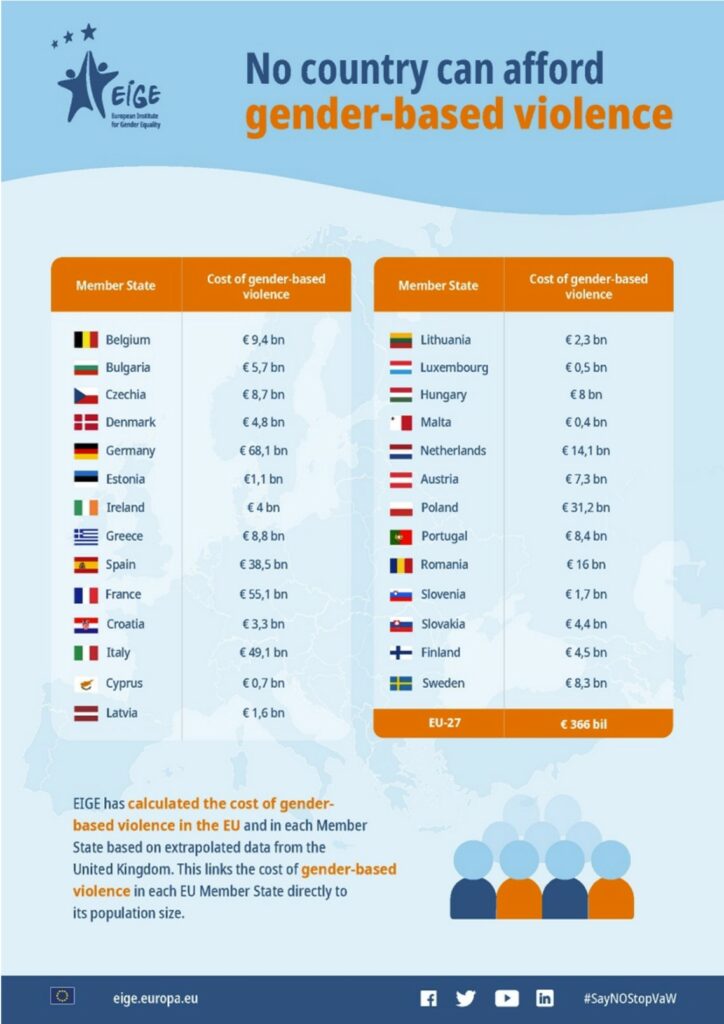
3. Age distribution of domestic violence
Tables of Perpetrators (by gender and age)
Table 3.1
| GENDER | MEN | |||||||||||
| PERPETRATOR’S AGE (YEARS) | 0-7 | 7-13 | 13-18 | 18-21 | 21-25 | 25-30 | 30-35 | 35-45 | 45-60 | 60-75 | 75+ | Τotal of male perpetrators |
| 10 | 0 | 93 | 135 | 270 | 529 | 704 | 2292 | 2585 | 748 | 205 | 7571 | |
Table 3.2
| GENDER | WOMEN | |||||||||||
| PERPETRATOR’S AGE (YEAR) | 0-7 | 7-13 | 13-18 | 18-21 | 21-25 | 25-30 | 30-35 | 35-45 | 45-60 | 60-75 | 75+ | Τotal of female perpetrators |
| 2 | 3 | 31 | 36 | 71 | 119 | 196 | 566 | 470 | 168 | 70 | 1732 | |
SOURCE: IMPLEMENTATION OF “DOMESTIC VIOLENCE” D.G.A./A.E.A. OF THE INFORMATION DIRECTORATE/A.E.A. FOR THE YEAR 2021
Tables of Victims (by gender and age)
Table 3.3
| GENDER | MEN | |||||||||||
| VICTIM’S AGE (YEARS) | 0-7 | 7-13 | 13-18 | 18-21 | 21-25 | 25-30 | 30-35 | 35-45 | 45-60 | 60-75 | 75+ | Τotal of male victims |
| 148 | 187 | 195 | 73 | 83 | 117 | 149 | 470 | 640 | 353 | 152 | 2567 | |
Table 3.4
| GENDER | WOMEN | |||||||||||
| VICTIM’S AGE (YEARS) | 0-7 | 7-13 | 13-18 | 18-21 | 21-25 | 25-30 | 30-35 | 35-45 | 45-60 | 60-75 | 75+ | Τotal of female victims |
| Total | 135 | 190 | 346 | 210 | 366 | 621 | 888 | 2120 | 1696 | 594 | 209 | 7375 |
ΠΗΓΗ: ΕΦΑΡΜΟΓΗ “ΕΝΔΟΟΙΚΟΓΕΝΕΙΑΚΗΣ ΒΙΑΣ” Δ.Γ.Α./Α.Ε.Α. ΤΗΣ ΔΙΕΥΘΥΝΣΗΣ ΠΛΗΡΟΦΟΡΙΚΗΣ/Α.Ε.Α. ΓΙΑ ΤΟ ΕΤΟΣ 2021
SOURCE: IMPLEMENTATION OF “DOMESTIC VIOLENCE” D.G.A./A.E.A. OF THE INFORMATION DIRECTORATE/A.E.A. FOR THE YEAR 2021
4. Number of deaths
Τable 4.1. Article 299 P.C. (homicide) in conjunction with Law 3500/06 on Domestic Violence, year 2021.
| with evidence of the crime of a. 299 P.C in conjunction with Law 3500/06 on Domestic Violence Year 2021 | ATTEMPTS | COMPLETED |
| Total | 24 | 34 |
SOURCE: IMPLEMENTATION OF “DOMESTIC VIOLENCE” D.G.A./A.E.A. OF THE INFORMATION DIRECTORATE/A.E.A. FOR THE YEAR 2021
Table 4.2. Data (sex and age) on the perpetrators of a. 299 bc in conjunction with law 3500/06 on domestic violence year 2021.
| PERPETRATOR’S AGE (YEAR) | 18-21 | 21-25 | 25-30 | 30-35 | 35-45 | 45-60 | 60-75 | 75+ | Total | ||||
| PERPETRATOR’S GENDER | Man | Man | Woman | Man | Woman | Man | Man | Woman | Man | Man | Woman | ||
| Attempted | 0 | 2 | 0 | 3 | 1 | 5 | 5 | 4 | 4 | 0 | 0 | 24 | |
| Completed | 1 | 0 | 1 | 3 | 0 | 5 | 15 | 1 | 3 | 3 | 2 | 34 | |
SOURCE: IMPLEMENTATION OF “DOMESTIC VIOLENCE” D.G.A./A.E.A. OF THE INFORMATION DIRECTORATE/A.E.A. FOR THE YEAR 2021
